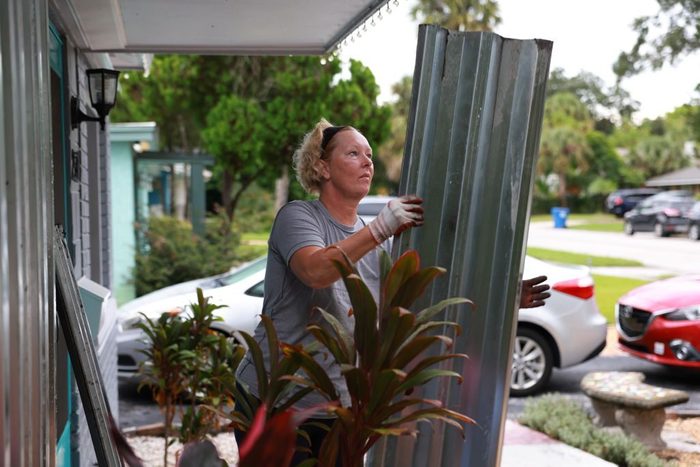
How to prepare for a hurricane
Staying safe during natural disasters like hurricanes comes down to planning. Whether it’s your first time weathering a storm or you’ve grown up in a hurricane zone, understanding how to prepare for a hurricane can mean the difference between minor wind damage and major destruction.
It’s not just wind, either. As our planet warms and seas rise, NASA expects hurricanes to bring more rainfall and higher storm surges. Katrina, one of the hurricane names you’re probably familiar with, may not rank as one of the strongest hurricanes ever based on wind speed, but the loss of life and property caused by Katrina’s 25-foot-plus storm surge was devastating.
Knowing how to prepare for a hurricane is just as essential as knowing how to prepare for a tornado and a wildfire. Like these other natural disasters, hurricanes can strike in many places, so even if you don’t live in a hurricane zone, you may still be at risk. Wherever you live, these hurricane-prep tips—from understanding your insurance policy to preparing your pets—will give you peace of mind when the next disaster strikes.
Get Reader’s Digest’s Read Up newsletter for more advice, humor, cleaning, travel, tech and fun facts all week long.
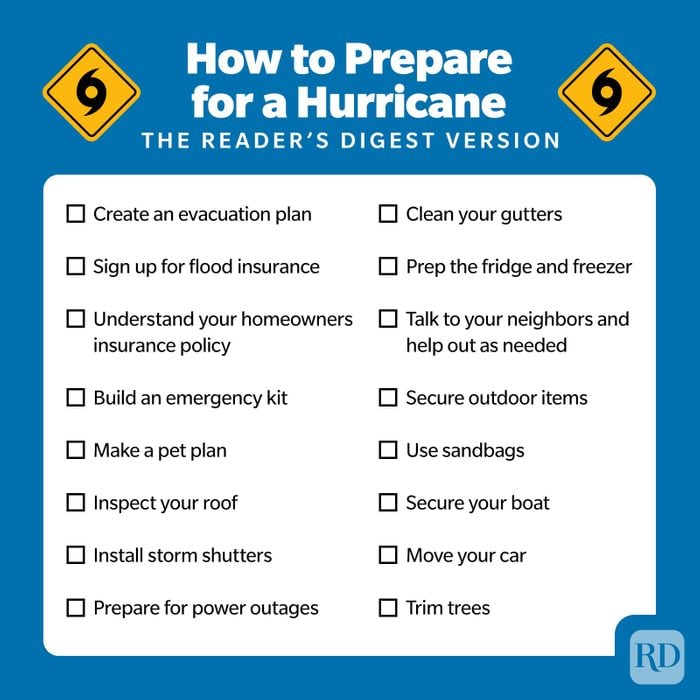
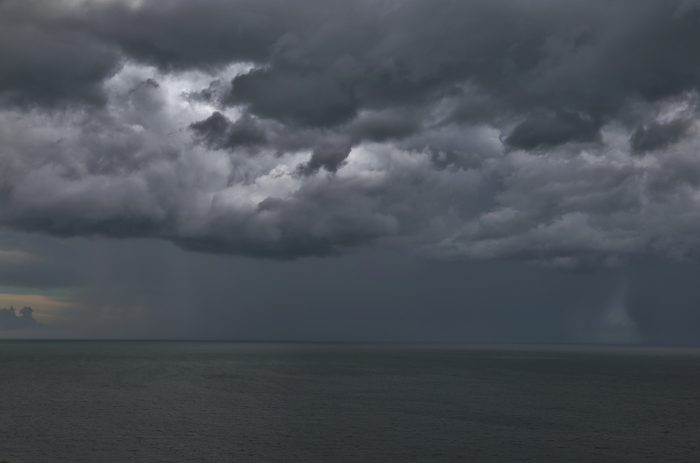
How do hurricanes form?
Here’s a quick meteorologic recap that’ll put you ahead of the curve the next time a hurricane is headed your way: Hurricanes need warm water and an existing weather system, such as a low-pressure tropical wave, to form. As the tropical system moves over the surface of the ocean, water evaporates and rises high in the air, where it cools and condenses, forming large clouds and releasing heat.
The resulting pressure differential (high pressure above, low pressure below) draws more air into the center as winds at the top of the storm push outward. This cycle of evaporation and condensation continues feeding the storm, and when winds reach 74 mph, the storm becomes a hurricane. (Wondering about the terms typhoon vs. hurricane? Both of these storms are technically called tropical cyclones, so the name you’re familiar with depends on where you live.)
Once a hurricane forms, wind speed determines the storm’s severity. The Saffir-Simpson Hurricane Wind Scale ranks the storms from Category 1, with sustained wind speeds of 74 mph to 95 mph, to Category 5, with winds clocking in at over 157 mph. But keep in mind: Wind is only one part of what makes a hurricane destructive.
Your local meteorologist isn’t the only one who benefits from understanding how hurricanes work. Armed with this information, you’ll have a better idea of whether a hurricane might hit your area and what you should do.
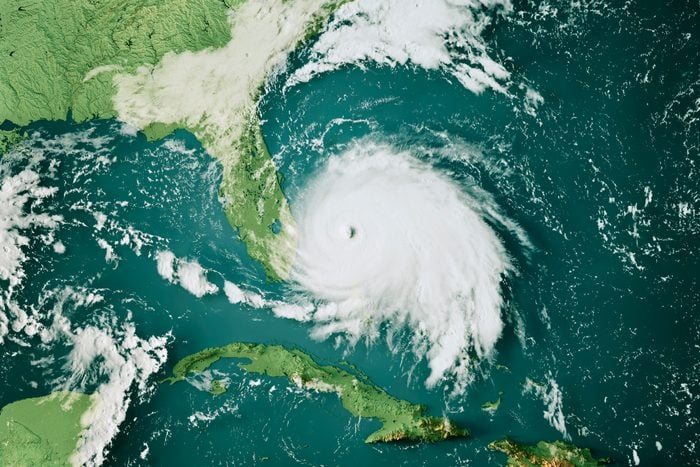
Determine your risk
Before you jump into planning, consider the risk you face based on where you live. States at the highest risk for hurricanes are Florida, Texas, Mississippi, Louisiana and North Carolina, according to the National Risk Index from the Federal Emergency Management Agency (FEMA). But anywhere on the East Coast or Gulf Coast of the United States is fair game. Miami has the highest risk of hurricanes, but Sandy, Ida and many others have made landfall in the upper Atlantic states over the years.
People who don’t live on the coasts should be prepared too. Rainfall and associated flooding often stretch for hundreds of miles inland, and thunderstorms and tornadoes are a risk as well. Here are a few tips for building a tornado-safe room.
The Historical Hurricane Tracks tool from the National Oceanographic and Atmospheric Administration (NOAA) allows anyone to see where hurricanes have landed around the world since tracking began. You can search by location, storm name, year and other metrics. NOAA’s National Hurricane Center is the place to track current storms. And if you’re curious about other weather-related disasters, read about what it feels like to be caught in a wildfire.
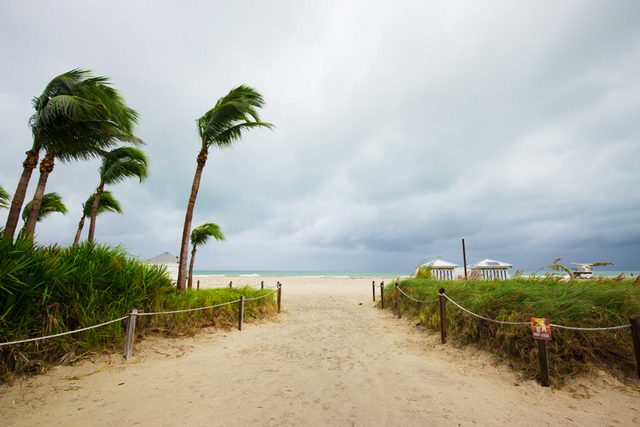
Create an evacuation plan
If you live in a hurricane-prone area, formulate an evacuation plan now so you’ll be ready when a storm comes. “Blue-sky days” are the time to plan, says Reid Loper, vice president of CrowderGulf, a disaster-recovery and debris-removal business in Mobile County, Alabama. Loper says that’s when you’re thinking with your rational mind and you’re less likely to make knee-jerk decisions. Don’t wait until the skies are threatening.
“Plan out where your nearest shelter is and the different routes you can take to those shelters,” Loper adds. Call ahead to shelters and hotels to make sure they can take your pets, and listen to local authorities. Many natural disaster survivors wish they had evacuated when warnings came. If you are not asked to evacuate, the safest place to be is an interior, lower-level room away from windows, according to the National Weather Service.
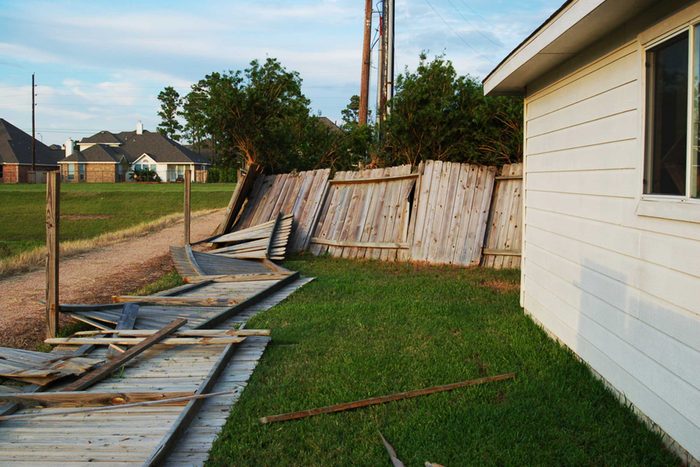
Understand your homeowners insurance
Don’t wait until you need it to figure out exactly what your homeowners insurance covers. Policies can be confusing, and you may be surprised at what homeowners insurance won’t cover. For example, most policies include wind damage from hurricanes but exclude flooding. You’ll need separate flood insurance for that, but there’s a 30-day waiting period for coverage to kick in, according to FEMA.
Many underwriters in Gulf states won’t write a policy after a named storm enters the Gulf of Mexico, adds Loper, so if you wait until a storm is approaching, it’s too late. Read and understand your policy now to avoid surprises. Make sure you have enough coverage to not only rebuild your home but also replace your possessions. Call your agent well in advance of hurricane season to discuss how to be prepared for a hurricane and to figure out any additional coverage you need.
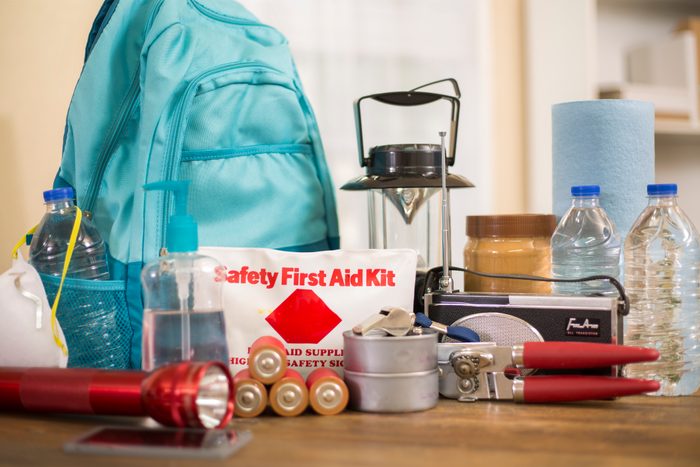
Build an emergency kit
Having a home emergency kit is critical no matter where you live, but it’s an absolute must when thinking about how to prepare for a hurricane. You can purchase a premade emergency kit (the American Red Cross makes great ones) or build your own. Ready.gov outlines what you need to stay safe, including fresh water for drinking and sanitation (one gallon per person per day), several days’ worth of non-perishable food items, a flashlight, a first-aid kit, a weather radio and more. Don’t forget to pack extra batteries.
Make sure you have all your essential medicines with you when you evacuate, says Loper. It’s a good idea to get out cash, too, and carry copies of important documents, like insurance policies, in a waterproof bag.

Make a plan for your pets
Our pets are members of our families, and they cannot fend for themselves during a hurricane or its aftermath. (But in case you’re wondering, here’s what happens to birds during a hurricane.) Whether you have to evacuate or are staying put, make a plan now so that when a storm comes, you’re not left scrambling to find shelter or food for your four-legged friend.
When you make a home emergency kit for your family’s human members, make a first-aid kit for your pets too. Food, water, medicine, kitty litter and toys are just a few of the items you should have on hand in case of emergencies. Ready.gov has a checklist of everything you need, including backup collars, ID tags and a picture of you with your pet in case you are separated.
Don’t forget: “Make sure that the shelters that you’ve identified for your evacuation, or fallback hotels that you’re going to go to, are pet-friendly,” advises Loper.
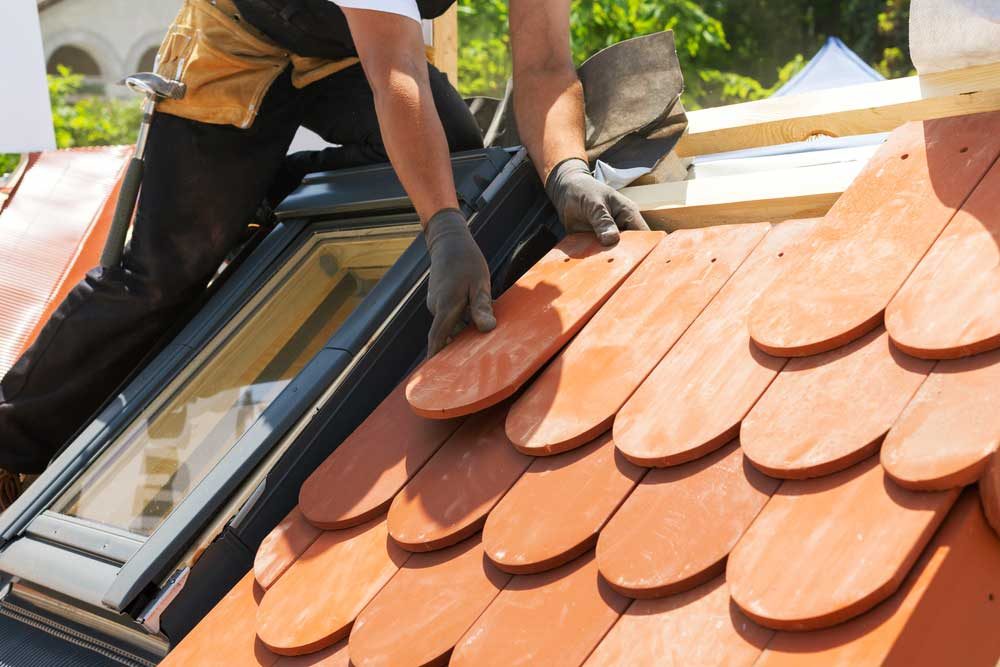
Inspect your roof
Missing shingles or clay tiles can compromise the integrity of your roof, leading to leaks or giving strong winds purchase to cause major damage. “Look for shingles near the roof edge that are brittle or loose,” says Michael Rimoldi, senior vice president of educational and technical programs at the Federal Alliance for Safe Homes.
Fix any missing or broken roof shingles or tiles well in advance of the storm. (Smart homeowners will do this even if a storm’s not brewing.) FEMA suggests installing impact-resistant materials when it’s time for a new roof and strapping the roof to the framing to prevent roof loss in a major wind event like a hurricane.
After a storm, watch out for hurricane scams. FEMA’s Blue Roof Program, which helps homeowners who have roof damage, does not charge for disaster assistance or inspections. If anyone shows up asking for money, do not pay, and report them to your local authorities.

Install storm shutters
Loper recommends installing hurricane shutters if you have them. If you’re buying new, expect to pay $5 to $6 per square foot for simple galvanized metal and $35 to $50 per square foot for shutters you control with your smartphone. The Federal Alliance for Safe Homes recommends choosing a material that’s been tested to withstand hurricane-force winds.
Plywood is another good option, and you can purchase it at home improvement centers. But it must have a minimum thickness of five-eighths of an inch to be effective, according to FEMA. Don’t bother taping your windows with X’s, though. This common weather myth creates more problems than it solves.
Storm shutters and plywood aren’t the only ways to protect your windows. “Some newly constructed homes have impact windows, or a fabric windscreen that is placed over the windows,” says Loper. If you live in a hurricane zone, consider upgrading your window protection to these newer tech options.
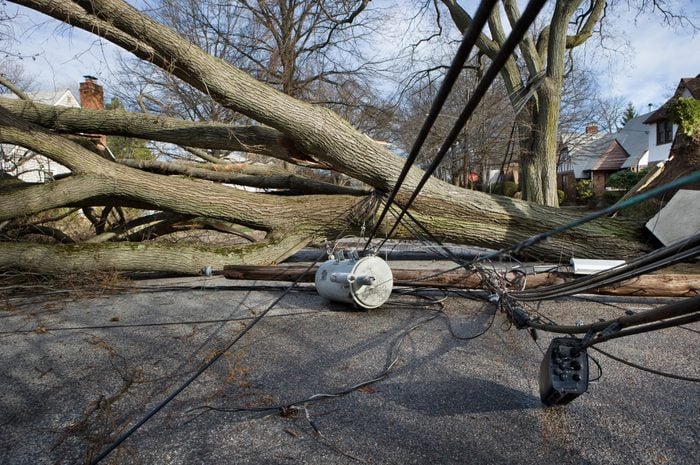
Prepare for power outages
Hurricane-force winds can easily topple power lines, so it’s important to know what to do when the power goes out. If your budget allows, install a whole-home generator or purchase a portable generator to keep the essentials running. Never run a portable generator indoors or gas it up while it’s running, though. “Always follow best-management practices when it comes to generator use,” says Loper.
A portable power bank is a more affordable option and will come in handy on camping trips and for other non-hurricane-related events. Candles, matches and lighters are always good to have on hand as well.
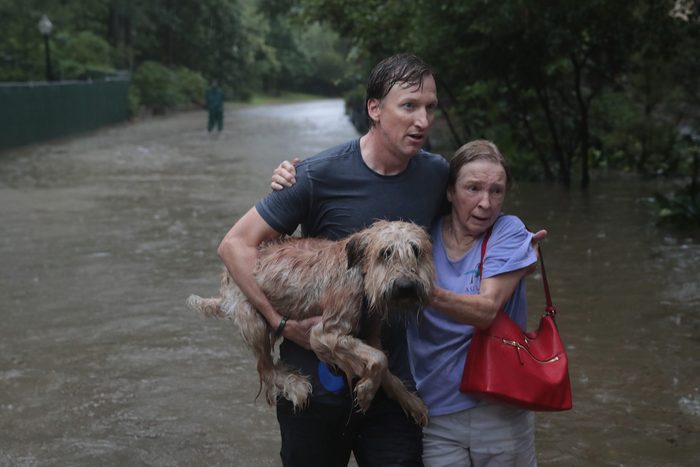
Talk to your neighbors
Before a hurricane hits, help your neighbors—especially elderly ones—by making sure they know how to prepare for a hurricane. Neighbors may not be able to get to the store, or they may have language barriers that prevent them from hearing or understanding evacuation orders. If you can, help them secure items in their yards if they are unable.
And if you’re wondering how to help after a natural disaster, talking to your neighbors is a great place to start. Working together after a storm, whether you’re sharing food, cleaning up or simply being a reassuring presence, can make the recovery process smoother.
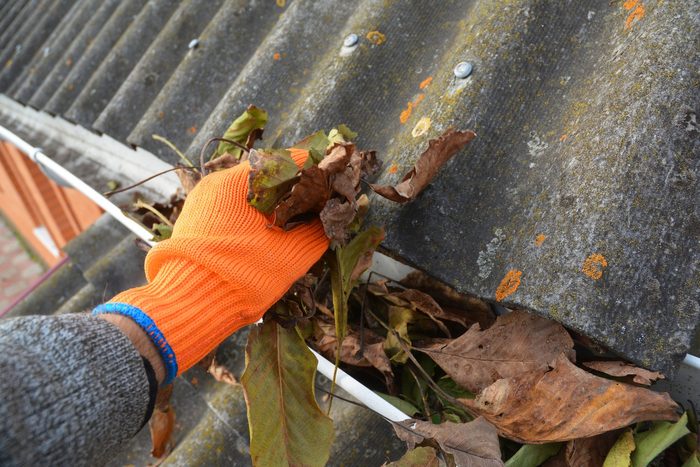
Clean your gutters
This is good advice any time of year, but it’s particularly important during hurricane season. No one likes cleaning gutters, but “having them flow properly allows water to move away from your home,” says Rimoldi. “Keeping them clean also prevents water from splashing back up against the roof and under the roof covering and causing damage.”
You can pay to have them professionally cleaned, or you can clean your gutters yourself with a sturdy ladder, work gloves and a gutter scoop. Whatever you do, don’t pressure-wash them. Pressure washers are powerful and can damage your gutters or even pull them off your house. Once you’ve cleared them of debris, check the drainage with a garden hose.
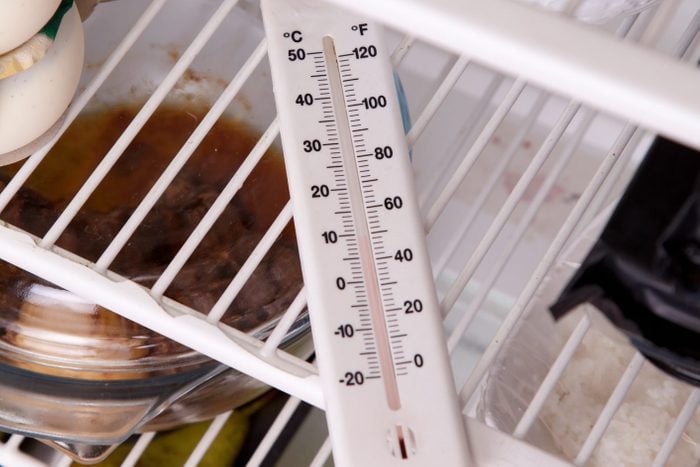
Place thermometers in the fridge and freezer
The best way to determine if perishable food is safe to eat when the power goes out is by temperature, according to the U.S. Department of Agriculture (USDA). Before the storm hits, place inexpensive appliance thermometers in your fridge and freezer.
A closed refrigerator keeps food safe for four hours; a fully stocked freezer for 48 hours. If your power is out longer than four hours, check the thermometers. If the temperature is above 40 degrees in the fridge, discard anything perishable. Frozen foods can be safely consumed or refrozen if they still have ice crystals on them or if the freezer is sitting at 40 degrees or below. If you’re heading out of town, this quarter trick can be a cue that you lost power during a storm and your fridge dipped below the recommended temperature.
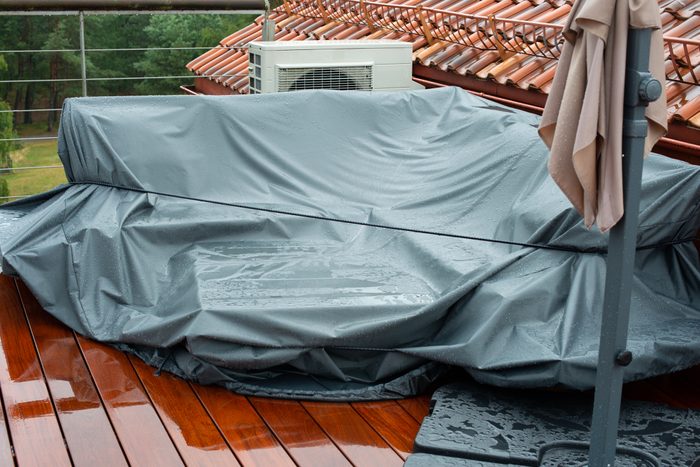
Secure outdoor items
Flying debris not only causes property damage, but it also can be a danger to anyone in its path. Anything left outside has the potential to become a missile, so it’s important to bring in or secure outdoor items. “We always hear the story about the homeowner who thought they had everything addressed, then forgot one lawn chair in the yard, and it ended up blowing around and broke a window,” says Rimoldi.
Loper adds that airborne debris is hazardous to both your home and safety and that of your neighbors’. Grills, doghouses, lawn furniture and trash cans cannot withstand the winds of a hurricane. Injury to occupants is a concern, and a direct hit can compromise a building’s integrity by allowing wind, rain and flooding inside. Bring in items you can, and strap down anything that’s too big to move.
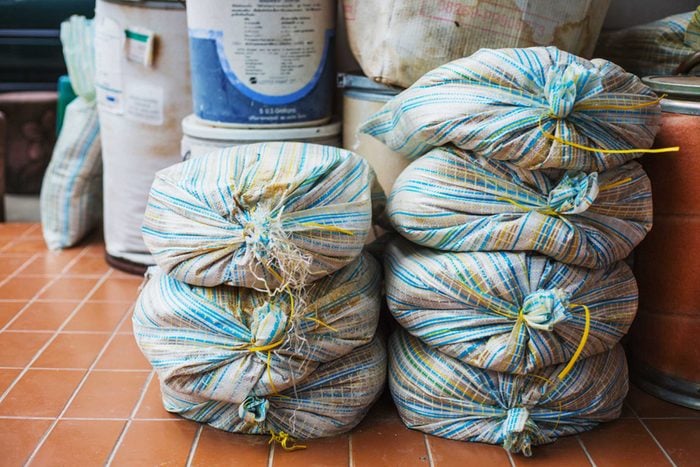
Use sandbags strategically
If you’re strategizing how to prepare your house for a hurricane, don’t overlook sandbags. While they won’t completely prevent flood damage, says Rimoldi, they will divert floodwater away from your home if placed in the right spots. They’re also useful for holding down plastic sheeting or reinforcing plywood barriers.
Loper doesn’t recommend sandbags if you’re in an evacuation zone. It takes time to fill and place them, and “it boils down to loss of property or loss of life,” he stresses. Where they can help is with inland flooding due to rain, where people have more time and water intrusion may be less.
Local governments sometimes offer residents a limited number of free sandbags when hurricanes approach. Purchase extra at your local hardware store, or make your own with pillowcases or trash bags. Dispose of the sand and bags when floodwaters recede. Next, learn the thunderstorm facts you missed in school.
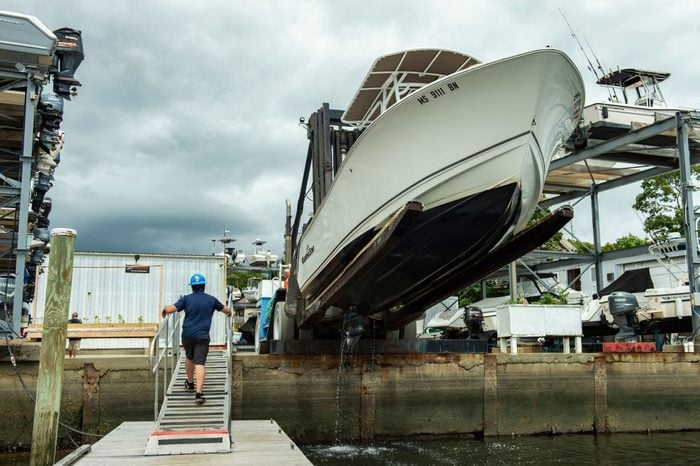
Secure your boat
The best place for your boat during a hurricane is on dry land far away from the coast. If that’s not possible, NOAA recommends trailering your boat out of the wind, pulling the drain plugs and anchoring the trailer and boat to the ground with a heavy line or chain. Do not store your boat trailer near power lines or trees, and remove anything that can become flying debris.
If your boat must stay on the water, develop a plan now. Options include mooring in an open canal away from other boats or using a dock that has high pilings so your vessel won’t become impaled. Practice your plan before a hurricane is imminent, and always follow maritime rules to minimize damage and danger to others.
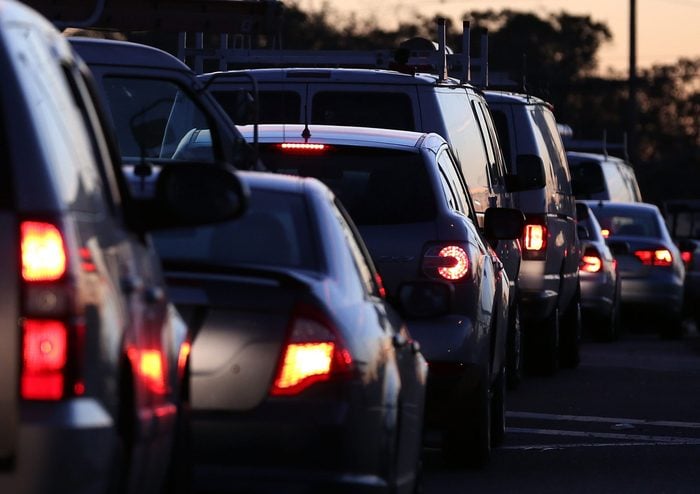
Move your car
Looper says that while many people evacuate in their cars, during Hurricane Ian, the storm surge came up so quickly, it caught a lot of people off guard. As a result, there were a tremendous amount of vehicles completely totaled in the waterways.
Just as you’d prepare your car for winter storms, you need to plan ahead for coming hurricanes. Loper recommends moving your cars inland if you have multiple vehicles that aren’t being used for evacuation. Inland parking garages can offer protection from wind and flooding, so seek one out if possible.
Whatever you do, do not attempt to drive through floodwaters. According to FEMA, it only takes a foot of water to wash away a car, even large ones like SUVs, and it’s very difficult to gauge water depth from your vehicle. Always follow the advice to “turn around, don’t drown” when driving your vehicle in proximity to a hurricane.
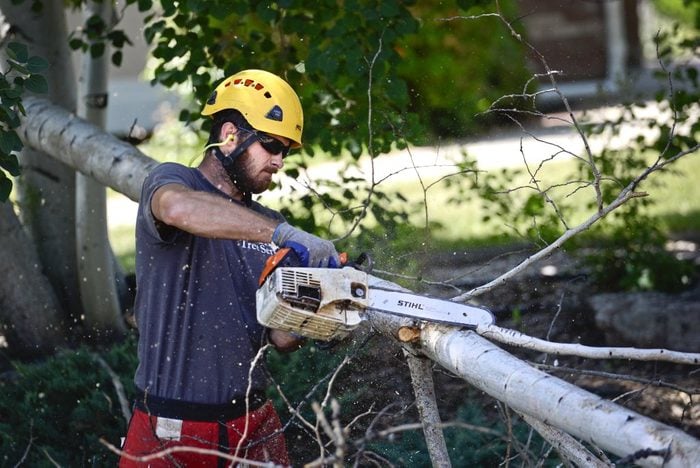
Trim trees and update landscaping
Not only can dead tree limbs and other vegetation fall on your house, but they can also become flying debris, says Loper. The disaster cleanup specialist suggests pruning and removing dead or dying vegetation annually. In addition to helping reduce danger during a hurricane, proper pruning will keep your trees healthy.
Many people have moved toward xeriscape landscaping, which reduces the need for irrigation in the age of climate change. In a hurricane zone, that can have adverse consequences if rocks and pebbles become projectiles during a storm. The Federal Alliance for Safe Homes recommends switching out rock landscaping for soft, fire-resistant mulch.
Additional reporting by Kaitlyn Chamberlin.
Sources:
- Reid Loper, vice president of CrowderGulf
- Michael Rimoldi, senior vice president of educational and technical programs at the Federal Alliance for Safe Homes
- FEMA
- NASA: “A Force of Nature: Hurricanes in a Changing Climate”
- National Oceanic and Atmospheric Administration
- National Weather Service
- Ready.gov: “Build a Kit”
- USDA: “Keep Your Food Safe During Emergencies”
